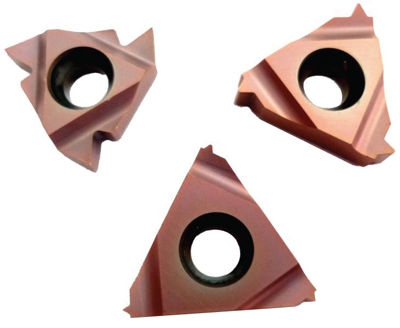
As more applications demand use of superhard alloys, manufacturers are demanding tooling that can deliver precision threads and high production in less time. To meet these challenges, Carmex Precision Tools Ltd. has engineered carbide grade HBA, an extra-fine, submicron grade with high toughness for optimized performance on hardened steel and cast iron up to 62 HRC, as well as titanium alloys and superalloys, including Hastelloy, Inconel and nickel-base alloys.
Available for internal and external threading in both 60 degree and 55 degree partial profile, as well as ISO metric and UN, HBA delivers high wear and heat resistance and excellent edge stability, according to the company. The unique combination of carbide substrate, coating type and edge conditions enhance performance over extended tool life. In a recent test involving an external right-hand thread: M32x1.5 and a length of 65mm in hardened steel D2: 53-56 HRC, a 16 ER 1.5 ISO grade HBA insert operated at 45 m/min at 28 passes produced 36 threads per corner.
According to Jeff Dei, president of Carmex USA, "Hard machining is increasingly becoming the rule rather than the exception in complex part production. Carmex HBA was engineered to meet the challenges inherent in threading hard materials while delivering high production and longer tool life. We invite our customers and others to bring us their most challenging applications and discover the benefits of engineered carbide performance."
Contact Details
Related Glossary Terms
- alloys
alloys
Substances having metallic properties and being composed of two or more chemical elements of which at least one is a metal.
- superalloys
superalloys
Tough, difficult-to-machine alloys; includes Hastelloy, Inconel and Monel. Many are nickel-base metals.
- threading
threading
Process of both external (e.g., thread milling) and internal (e.g., tapping, thread milling) cutting, turning and rolling of threads into particular material. Standardized specifications are available to determine the desired results of the threading process. Numerous thread-series designations are written for specific applications. Threading often is performed on a lathe. Specifications such as thread height are critical in determining the strength of the threads. The material used is taken into consideration in determining the expected results of any particular application for that threaded piece. In external threading, a calculated depth is required as well as a particular angle to the cut. To perform internal threading, the exact diameter to bore the hole is critical before threading. The threads are distinguished from one another by the amount of tolerance and/or allowance that is specified. See turning.






